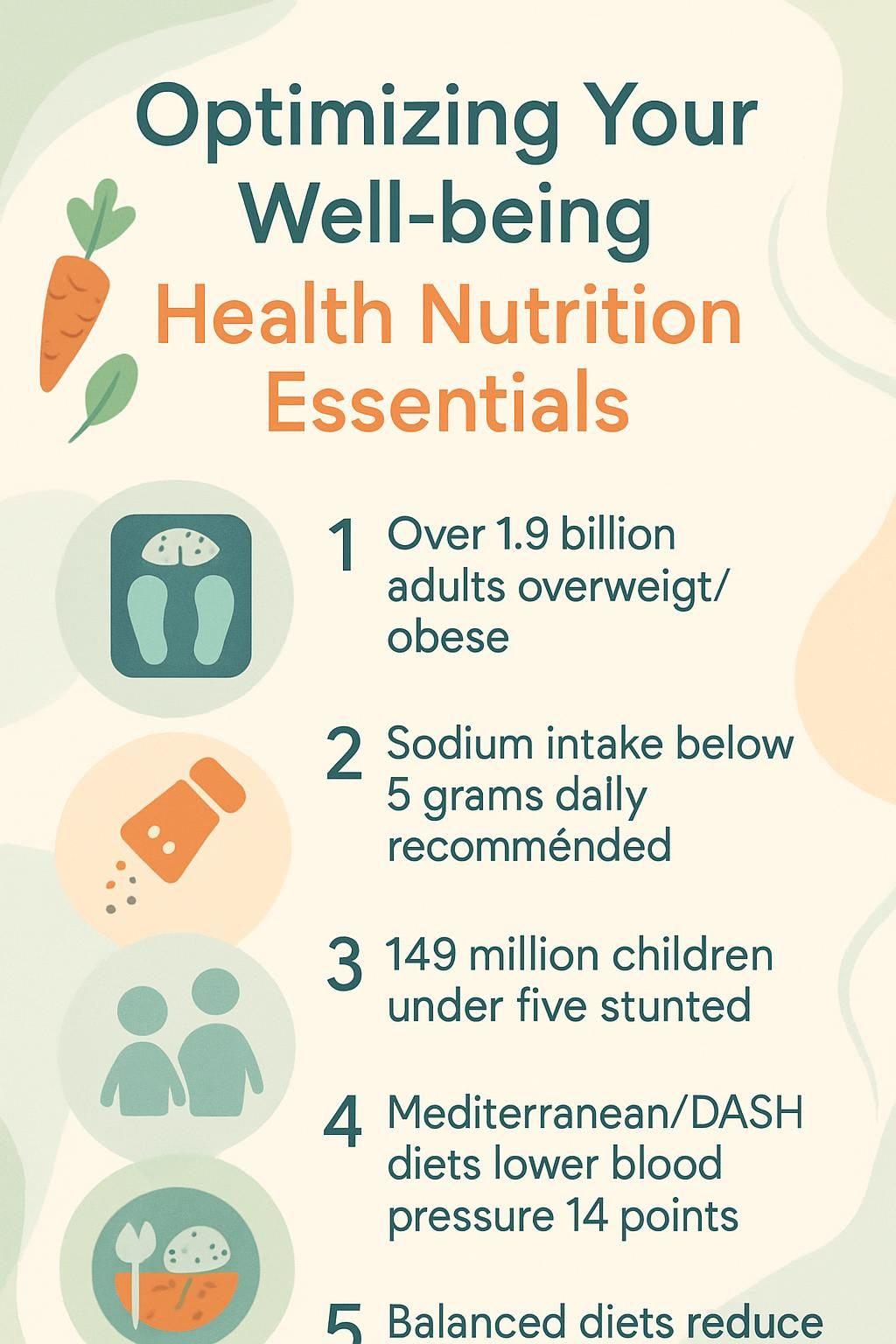Optimizing Your Well-being: Health Nutrition Essentials
Our Nutrition Assistant AI Suite will transform your body. You will lose fat, get toned, and build muscle. Gain confidence and optimal health.
Healthy eating can feel confusing, especially with so much advice online. Yet nutrition shapes energy, mood, and long-term health every day. A healthy diet lowers the risk of heart disease and diabetes, and it helps you feel steady and focused.
This guide gives you clear facts on balanced eating, the nutrients you need, and simple steps you can use right away. The guidance draws on sources such as the World Health Organization and Nutrition.gov so you can act with confidence.
Use the practical tips below to improve health nutrition one meal at a time. Small changes today can build strong habits over the months ahead.
Key Takeaways
- Over 1.9 billion adults live with overweight or obesity. Poor nutrition raises the risk of heart disease, diabetes, and early death worldwide, according to the WHO.
- Balanced eating includes fruits, vegetables, whole grains, lean proteins, healthy fats, vitamins, minerals, fiber, and water. A pattern like this reduces chronic disease risk.
- Keeping daily sodium below 5 grams helps control high blood pressure. Many adults eat almost twice that amount.
- Lack of key nutrients harms growth in young children. About 149 million have stunted growth and roughly 40 percent face anemia.
- The Mediterranean and DASH diets can lower blood pressure up to 14 points and cut heart attack or stroke risk by about 30 percent, per clinical evidence.

Understanding Health and Nutrition

Nutrition and health guide your daily choices, from breakfast to late-night snacks. Knowing the basics helps you build a healthy diet and lower the risk of chronic problems.
What Are Health and Nutrition?
Health is how well your body and mind work together. Nutrition is the study of food, how your body uses it, and how nutrients help you grow and stay well. A balanced diet that includes fruits, vegetables, whole grains, lean proteins, healthy fats, vitamins, minerals, and dietary fiber supports strong bones, stable energy, brain function, and your immune system.
Good nutrition helps students learn and helps adults perform at work. The United States Department of Agriculture shares guidelines that prevent malnutrition and common nutrient gaps.
In 2020, about 149 million children showed stunted growth due to poor nutrient intake. Stunting harms learning and limits family income over time.
Meeting daily needs for protein, carbohydrates, and healthy fat, while limiting trans fat and added sugar, reduces the risk of obesity and heart disease. Breastfeeding supports ideal nutrition in infancy and lowers both underweight rates and future obesity risk.
Why Is a Balanced Diet Important?
A balanced diet supports every system in your body, from immunity to mood. It helps you reach recommended intakes for vitamins and minerals such as iron, choline, iodine, and fluoride.
In areas with food insecurity, enough essential nutrients prevent malnutrition and disease. Nearly 45 percent of deaths among children under five relate to undernutrition, based on global data. Only 44 percent of infants receive exclusive breastfeeding for six months, which leaves many at risk.
Healthy patterns limit added sugars and trans fats, and they replace lard or palm oil with better options. These steps help manage weight and cholesterol. During pregnancy, balanced meals with whole grains and lean protein support energy, growth, and maternal checkups.
Nutrition is not just about eating; it’s about learning to live.
Which Nutrients Are Essential for Well-being?
Knowing why balance matters leads to the question of which nutrients you truly need. Food supplies more than calories, it delivers key building blocks for your body and brain.
- Protein supports muscle repair and growth. Sources like nuts, lean meat, eggs, or beans help recovery and daily energy.
- Carbohydrates provide your main fuel. Choose whole grains such as wheat, rye, oats, or whole grain cereal to steady blood sugar and curb hunger.
- Healthy fats from foods like olive oil, nuts, seeds, and fish aid vitamin absorption and brain function. Limit saturated fats to protect cholesterol levels.
- Vitamins A, C, D, E, and K support vision, immunity, bones, and skin. Eat a rainbow of produce for broad vitamin coverage.
- Minerals such as iron are needed for red blood cells. About 40 percent of children under five face anemia related to iron deficiency.
- Fiber helps control appetite and supports heart and gut health. Aim for whole grains and starchy vegetables at meals.
- Water prevents dehydration and keeps your organs working well throughout the day.
- Sodium intake should stay below 5 grams per day. Many adults consume 9 to 12 grams, which raises the risk of hypertension.
- Some people need dietary supplements if food intake falls short. Talk with a healthcare professional before starting any supplement.
A simple example helps: track your sodium with an app for one month. Most people discover their intake is higher than they thought.
The Fundamentals of a Healthy Diet
A healthy diet brings clear health benefits and helps prevent non-communicable disease. Nutritious foods help you reach your Reference Daily Intake for protein, vitamins, minerals, and total fat.
What Are the Benefits of Eating Fruits and Vegetables?
Fruits and vegetables are rich in vitamins, minerals, and fiber. The 2020–2025 Dietary Guidelines for Americans name them as core parts of healthy eating patterns for every age.
Adding produce to meals supports good nutrition and lowers the risk of diabetes and heart disease. These foods are naturally low in total fat and contain no cholesterol.
People who eat more fruits and vegetables often have lower blood pressure and healthier weight. Many studies suggest at least five servings per day for better longevity and well-being.
Eating plenty of fruits and vegetables is one simple way to boost health every day.
Next, see why whole grains earn a regular spot beside your favorite produce.
Why Choose Whole Grains?
Whole grains such as oats, barley, and whole-wheat flour deliver powerful benefits. They supply dietary fiber that supports digestion, helps control blood sugar, and lowers heart disease risk.
Research shows that three servings of whole grains a day can cut chronic disease risk by up to 30 percent. Try oatmeal, whole-wheat waffles, or brown rice to increase fiber and support steady energy.
Evidence-based choices featured by groups like Mayo Clinic appear in many healthy cookbooks. They help prevent and manage conditions such as diabetes and hypertension.
How Do Lean Proteins Support Health?
Lean proteins protect muscle and support tissue repair. The 2020–2025 Dietary Guidelines for Americans recommend skinless poultry, fish, eggs, beans, and low-fat dairy.
These choices contain less saturated fat than fatty or processed meats. They support heart health and can help manage cholesterol levels. Greek yogurt, for example, makes a smart snack that boosts focus and steady energy.
Lean proteins also supply iron and zinc, two minerals that support immunity and cell growth.
What Are Healthy Fats and Why Do They Matter?
Healthy fats come from nuts, seeds, olive oil, fish, and avocados. Your body uses these fats to absorb vitamins and build cells. They can lower the risk of heart disease by improving cholesterol patterns.
Industrial trans fats raise disease risk and appear in many processed foods. The World Health Organization set a global goal to remove trans fat from the food supply in 2018. Replacing it with healthier oils supports well-being at every age.
How Does Hydration Affect Your Health?
Water helps move nutrients, control body temperature, and clear waste. Even mild dehydration can cause headaches, low energy, and trouble focusing.
Keep a bottle nearby and sip throughout the day. Many people find that regular water breaks improve skin, mood, and workout performance.
Nutrition Across Different Life Stages
Your nutrition needs shift as you grow and age. Adjusting your diet helps protect long-term health and day-to-day energy.
What Nutritional Needs Do Children and Adolescents Have?
Children and teens need balanced meals, steady hydration, and skills that build lifelong habits. Growth is rapid in these years, so consistent nutrition matters.
- Children under five face high rates of malnutrition. About 149.2 million are stunted worldwide due to poor diets or limited food supply.
- Wasting affects about 45.4 million children, with many cases in Asia where poverty limits access to nutritious foods.
- A balanced plate at meals supports growth. Include fruits, vegetables, whole grains, lean proteins, and healthy fats.
- Iron is crucial since 40 percent of young children have anemia. Beans, fortified cereals, and lean meats help raise iron levels.
- Calcium and vitamin D build strong bones during adolescence. Dairy foods and safe sunlight help cover needs.
- Limit processed foods high in added sugars or trans fats. These raise the risk of obesity and future disease.
- Hydration supports brain function and energy. Offer water instead of sugary drinks.
- Hunger harms attention in school. Regular nutritious meals improve learning and behavior.
- Teach label reading and basic nutrition. These skills beat fad diets and help kids make smart choices.
This approach strengthens health during key growth windows and supports better school performance.
How Should Adults Manage Their Nutrition?
Adults need steady habits that support weight, energy, and disease prevention. Simple steps make change easier to sustain.
- Review your current diet and set small, realistic goals. Digital tools can help you track progress.
- Eat a variety of fruits and vegetables daily. Aim for at least five servings.
- Choose whole grains over refined grains to increase fiber and steady energy.
- Pick lean proteins like chicken, beans, or fish to protect muscle and limit saturated fat.
- Use healthy fats from nuts, seeds, avocados, or olive oil for heart and brain support.
- Drink enough water based on activity and climate. Hydration aids digestion and focus.
- Limit added sugars and trans fats by checking labels. This helps prevent weight gain.
- Watch portion sizes at every meal. Many adults worldwide live with overweight or obesity.
- Check in with a healthcare professional as needs change with age.
These basics build a flexible plan you can adjust over time.
What Are the Best Nutrition Practices for Seniors?
Nutrient needs change with age, so smart choices protect strength and independence. These steps support physical and mental health in later years.
- Fill half your plate with fruits and vegetables for vitamins, minerals, and antioxidants. Aim for five servings per day.
- Choose whole grains like oatmeal, brown rice, or whole-wheat bread to raise fiber intake.
- Include lean protein at each meal. Fish, poultry, eggs, beans, and low-fat dairy help preserve muscle.
- Use healthy fats such as olive oil, nuts, seeds, and avocados. Keep saturated fats low.
- Stay hydrated with water as your main drink. Many older adults need about eight cups daily.
- Prioritize calcium and vitamin D to support bone health. Supplements may help if intake is low.
- Watch portions and limit highly processed foods that are high in sodium and added sugars.
- Check labels for lower sodium, lower sugar, and better fat profiles.
- Cook at home using trusted, senior-friendly recipes for balanced meals.
- Practice mindful eating and share meals when possible. This supports nutrition and joy at the table.
A simple starter plan, such as a weekly menu with calcium-rich foods, can boost energy within weeks.
What Are Key Nutrition Tips for Pregnancy and Maternal Health?
During pregnancy, nutrition supports your health and your baby’s growth. Focus on quality foods and steady hydration.
- Eat iron-rich foods daily. About 37 percent of pregnant women have anemia. Lean meats, beans, and fortified cereals can help.
- Include many fruits and vegetables for key vitamins and minerals. Aim for at least five servings a day.
- Pick whole grains like brown rice and oatmeal for lasting energy and healthy weight gain.
- Get folic acid from leafy greens, lentils, and fortified breads. It helps prevent early birth defects.
- Meet calcium needs with dairy or fortified plant milks to protect bones for you and your baby.
- Drink water throughout the day. Dehydration raises risks during pregnancy.
- Limit processed foods high in added sugars or trans fats. They add calories without key nutrients.
- Monitor salt if you have high blood pressure or risk factors for hypertension.
- See your healthcare professional regularly. They may recommend prenatal supplements.
- Track weight gain with clinical guidance. Both low and high gain can affect infant outcomes.
- Try smaller, frequent meals if you feel nauseated or have heartburn.
The Connection Between Nutrition and Disease Prevention
Daily food choices can lower your risk of chronic disease. Evidence-based patterns offer strong protection for long-term health.
How Can Diet Lower the Risk of Heart Disease?
To protect your heart, center meals on fruits, vegetables, whole grains, and healthy fats. Limit saturated fat and cholesterol from fatty meats and processed foods.
Choose lean proteins like poultry, fish rich in omega-3s, and nuts. Reducing sodium helps as well. Fiber-rich foods can lower LDL, or bad cholesterol. Swapping white bread for whole grain options may lower total cholesterol by 5 to 10 percent.
Small changes add up over months. Many people report better energy and lower blood pressure after shifting to a heart-friendly pattern.
What Are Dietary Strategies for Managing Diabetes?
Balanced meals and well-timed snacks help manage blood sugar. Focus on high-fiber foods such as whole grains, beans, nuts, fruits, and vegetables.
Limit processed foods high in added sugars and unhealthy fats. Aiming for 25 to 30 grams of fiber per day can improve A1C in people with type 2 diabetes. Spread carbohydrates evenly across meals, drink water instead of sugary drinks, and control portions.
Fill half your plate with non-starchy vegetables like leafy greens and broccoli. A food diary can help you spot patterns that stabilize glucose levels.
How Does Nutrition Help Control Hypertension?
Reducing sodium lowers blood pressure. The DASH diet recommends more fruits, vegetables, whole grains, and low-fat dairy, while cutting salt.
Processed foods often hide extra salt, so cook more at home and flavor with herbs. One teaspoon of table salt contains about 2,300 milligrams of sodium, which meets the American Heart Association’s daily limit for many adults.
Eating well gives you another tool to control a major risk factor, along with any treatment from your clinician.
How Can You Prevent Obesity Through Nutrition?
Weight control starts with nutrient-dense foods. Fill your meals with produce, whole grains, and lean proteins. Limit sugary snacks and drinks, which add calories without nutrients.
Portion awareness matters. Use smaller plates, pre-portion snacks, and eat slowly. Globally, about 38.9 million children under five live with overweight. Household changes, like swapping fried foods for grilled options, can make a clear difference.
Popular Nutrition Trends and Diets
Trends can be helpful if they are grounded in science. The plans below have research behind them, with different strengths and trade-offs.
What Is the DASH Diet and Its Benefits?
DASH means Dietary Approaches to Stop Hypertension. It emphasizes fruits, vegetables, whole grains, lean proteins, and low-fat dairy. Research shows it can reduce systolic blood pressure by 8 to 14 points in people with hypertension.
DASH limits sodium to about 2,300 milligrams per day, or less for some adults, and reduces added sugars and unhealthy fats. It raises fiber, potassium, calcium, and magnesium. Many people also see better cholesterol numbers on this plan.
A sample day might include oatmeal with berries and a grilled chicken salad. The meals are simple, filling, and easy to repeat.
How Do Plant-Based Diets Affect Health?
Plant-forward eating lowers risk for heart disease and diabetes. Meals centered on vegetables, fruits, legumes, whole grains, nuts, and seeds can improve cholesterol, stabilize blood pressure, and support a healthy weight.
Reducing red meat often improves digestion due to higher fiber. A practical way to start is adding one meatless dinner each week and building from there.
Summary: Diets rich in nutrient-dense plants support health across life stages and lower disease risk.
What Are the Pros and Cons of Low-Carb and Keto Diets?
Low-carb and keto approaches can help some people manage weight and blood sugar. They also carry trade-offs that you should consider with a clinician if you have medical conditions.
| Aspect | Pros | Cons |
|---|---|---|
| Weight Loss |
|
|
| Blood Sugar & Insulin |
|
|
| Heart Health |
|
|
| Nutrient Intake |
|
|
| Side Effects |
|
|
| Sustainability & Social Factors |
|
|
| Expert Opinion |
|
|
You may want to compare these approaches with the Mediterranean diet next, since it has broad support from researchers.
Why Is the Mediterranean Diet Recommended?
The Mediterranean diet favors balance. You build meals around plant foods, extra-virgin olive oil, fish and poultry, with moderate dairy intake.
Large studies show strong heart benefits. A landmark trial reported a 30 percent lower risk of heart attack or stroke compared to a standard low-fat diet. Many people also see better cholesterol numbers.
This pattern does not cut entire food groups. Instead, it nudges your plate toward nutrient-rich choices supported by science.
Practical Tips for Optimizing Nutrition
Healthy eating gets easier with a plan. Use the steps below to turn goals into daily habits.
How Can You Plan and Prepare Healthy Meals?
Planning and prep save time and reduce stress. A weekly routine helps you cover key food groups and stay on budget.
- Use a weekly meal planner to map breakfast, lunch, dinner, and snacks.
- Build plates with produce, whole grains, lean proteins, and healthy fats.
- Shop from a list to avoid impulse buys and lower food waste.
- Batch-cook staples like brown rice, chicken breasts, and roasted vegetables.
- Lean on evidence-based recipes for quick, healthy ideas.
- Portion meals into containers for easy grab-and-go options.
- Track eating patterns to spot wins and gaps.
- Read ingredient lists to limit added sugars and ultra-processed foods.
- Fill a reusable bottle each morning to keep hydration on track.
- Adjust recipes for your needs, using credible guidance.
- Review what worked and refine next week’s plan.
What Should You Look for When Reading Nutrition Labels?
Labels help you compare foods at a glance. Understanding a few parts of the label makes choices faster and safer.
- Start with serving size at the top. All numbers on the label match that amount.
- Check calories per serving to manage intake.
- Scan saturated fat, trans fat, and cholesterol. Keep these low to support heart health.
- Look at sodium and aim for less than 2,300 milligrams per day.
- Review total and added sugars. Added sugars now appear in grams.
- Check protein if you want to support muscle and steady energy.
- Find dietary fiber under carbohydrates. Aim for at least 3 grams per serving when possible.
- Note vitamin D, calcium, iron, and potassium. These nutrients support overall well-being.
- Use Percent Daily Value. Five percent DV is low, 20 percent DV is high.
- Read ingredient lists in order of amount used, from most to least.
- Choose products with whole grains and fewer artificial ingredients.
How Can You Incorporate Healthy Snacks into Your Diet?
Smart snacks steady blood sugar and prevent overeating later. Plan a few go-to options and keep them handy.
- Pick whole foods like fruit, raw vegetables, nuts, or seeds for fiber and vitamins.
- Test kid-friendly options such as oat waffles made with nuts for a satisfying bite.
- Prep snacks ahead to avoid ultra-processed choices high in added sugars and trans fats.
- Rotate snack ideas from trusted cookbooks to keep choices fresh and appealing.
- Pair protein with carbs, for example, Greek yogurt with berries or peanut butter on whole grain toast.
- Use small containers to manage portions and calories.
- Switch choices with the seasons to add variety and reduce cost.
Many people find that replacing vending machine snacks with pre-cut vegetables and hummus leads to steadier afternoon energy.
How Do You Reduce Added Sugars and Trans Fats?
Lowering added sugars and removing trans fats supports heart health and reduces chronic disease risk. The WHO has called for eliminating industrial trans fats from foods worldwide.
- Read labels to spot added sugars and partially hydrogenated oils, which indicate trans fats.
- Cook at home more often so you control ingredients and portions.
- Swap soda and sweet tea for water or unsweetened drinks.
- Choose whole fruits, nuts, and seeds instead of packaged sweets.
- Use oils like olive, avocado, or canola for cooking.
- Check restaurant nutrition info and avoid items labeled fried, creamy, or sweetened.
- Limit store-bought baked goods, which often contain both sugars and trans fats.
- Reducing salt helps, since many salty processed foods also contain sugar and unhealthy fats.
- Use recipes that show how to cut added sugars and choose healthier fats.
- Reach for spices like cinnamon or vanilla to add flavor in place of sugar.
- Support policies that remove industrial trans fats from the food supply.
The Role of Physical Activity in Overall Well-being
Food and movement work together like a team. Pair smart nutrition with regular activity to amplify benefits.
How Does Combining Nutrition with Fitness Improve Health?
Balanced meals and consistent exercise help manage weight, improve blood sugar, and strengthen muscles and bones. Lean proteins plus training support muscle growth and faster recovery.
Use simple logs to track both workouts and meals. You will see how pre-workout snacks, hydration, and protein timing affect performance and energy.
Better mood, focus, and sleep often follow this combo. It also supports heart health and easier recovery after tough sessions.
What Are the Benefits of Regular Exercise?
Regular exercise lowers the risk of type 2 diabetes, obesity, and hypertension. It strengthens the heart and supports healthy blood pressure.
Many people notice better mood, more energy, and deeper sleep after starting a routine. Even a brisk 30-minute walk most days can reduce stress and increase alertness at work.
Movement reduces daily fatigue for both adults and children. Make it part of your routine, like brushing your teeth.
The Importance of Mental Health in Nutrition
Food choices and mood feed into each other. The right foods can support a calmer, steadier day.
How Does Stress Influence Eating Habits?
Stress often changes appetite and food choices. Many people reach for calorie-dense snacks during tense moments or skip meals when anxious.
Cravings for sugar-rich foods can rise, and irregular eating becomes common. Before exams or deadlines, you might grab junk food out of habit rather than hunger.
About 27 percent of adults report overeating unhealthy foods due to stress. Building steady eating patterns makes stress easier to manage and keeps energy more stable.
Summary: Stress can trigger cravings and irregular meals that harm both physical and mental well-being.
Which Foods Support Mental Health?
Foods high in antioxidants, vitamins, and healthy fats support brain health. Berries and leafy greens stand out. Salmon and other fatty fish provide omega-3 fats that help the brain work well.
Whole grains such as brown rice support steady energy for mood balance. Dark chocolate contains flavonoids that may reduce stress signals. Beans and seeds offer magnesium, which supports the nervous system.
Many people notice sharper focus on days they include walnuts or blueberries at breakfast. Diets rich in plants, lean proteins, and unsaturated fats link to lower depression risk in studies.
Choosing Science-Based Nutrition Information
Science-based guidance protects you from hype and quick fixes. Use credible sources and simple checks to verify claims.
How Can You Separate Nutrition Facts from Myths?
Look for peer-reviewed research and trusted organizations. Groups like Mayo Clinic and the Centers for Disease Control and Prevention share evidence-based advice rather than product endorsements.
Be wary of miracle diet claims that lack citations. Use official guidelines and balanced plates as your baseline. That approach reduces confusion and keeps your well-being at the center of each choice.
What Are Trusted Sources for Nutrition Research?
Reliable information comes from agencies, professional groups, and peer-reviewed journals. These sources check facts and update guidance as new research appears.
- HHS and USDA publish the Dietary Guidelines for Americans every five years.
- The Academy of Nutrition and Dietetics provides research-based factsheets and expert statements.
- The World Health Organization shares global nutrition data and standards.
- The Office of Dietary Supplements maintains detailed profiles on vitamins, minerals, and supplements.
- Peer-reviewed journals, such as The American Journal of Clinical Nutrition, evaluate studies before publication.
- University websites often summarize large clinical trials in plain language.
- Registered dietitians give personal advice based on current evidence.
These references help you separate facts from myths and support a healthy diet at home.
Conclusion
You can shape your well-being one choice at a time. A healthy diet rich in fruits, vegetables, whole grains, lean proteins, and healthy fats gives your body the nutrients it needs.
Nutritious eating protects against heart disease and diabetes, and it supports mental health. Use science-based resources like Nutrition.gov and the World Health Organization for reliable guidance.
Start small and stay consistent. The steps you take today can build a stronger mind and body in the months ahead.
This article is for education only and does not replace personalized medical advice. Speak with a healthcare professional for diagnosis, treatment, or specific nutrition guidance.
FAQs
1. What are the key nutrition essentials for improving well-being?
A balanced intake of macronutrients, such as proteins, carbohydrates, and fats, supports energy needs and body function. Micronutrients like vitamins A, C, D, E, calcium, iron, and potassium help maintain immune health and bone strength. According to the Centers for Disease Control and Prevention (CDC), most adults do not meet daily recommendations for fruits or vegetables.
2. How does hydration affect overall health?
Proper fluid intake regulates temperature control and aids digestion while supporting cognitive performance. The National Academies recommend about 3.7 liters per day for men and 2.7 liters per day for women from all beverages and foods combined.
3. Can personal experience guide healthy eating choices?
Personal experiences often shape food preferences; however evidence-based guidelines should direct dietary decisions to ensure nutritional adequacy across life stages.
4. Why is it important to use credible sources when learning about nutrition?
Relying on trusted organizations like the World Health Organization or peer-reviewed journals ensures that information reflects current scientific understanding rather than trends or myths.
Summary: Nutrition essentials include a balance of macro- and micronutrients along with proper hydration based on scientific guidance from reputable sources; these steps support lasting well-being through informed choices grounded in reliable data rather than anecdote alone.







